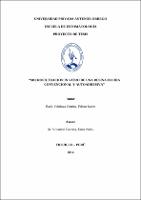Mostrar el registro sencillo del ítem
Microfiltracion in vitro de una resina fluida convencional y autoadhesiva
| dc.contributor.advisor | Villarreal Becerra, Einer Niels | |
| dc.contributor.author | Cordova Cotrina, Edson Javier | |
| dc.creator | Cordova Cotrina, Edson Javier | |
| dc.date.accessioned | 2015-09-15T15:50:21Z | |
| dc.date.available | 2015-09-15T15:50:21Z | |
| dc.date.issued | 2014 | |
| dc.identifier.uri | https://hdl.handle.net/20.500.12759/1106 | |
| dc.description.abstract | Objetivo: Comparar el grado de microfiltración in vitro de una resina fluida convencional y autoadhesiva, en dientes anteriores de bovino. Materiales y Método: Los dos sistemas utilizados fueron: Grupo A resina fluida convencional (3MTM FiltekTM Z350 XT) y Grupo B resina autoadhesiva (DyadTM Flow Kerr). Se prepararon 30 dientes anteriores de bovino con cavidades clase V y se asignaron al azar en 2 grupos (Grupo A y B), con 15 dientes de bovino para cada grupo, se realizaron las restauraciones siguiendo las especificaciones del fabricante. Después de ser restauradas las muestras se sometieron a termociclado (300 ciclos entre 5°C y 55°C) en agua destilada y se sumergieron en una solución de azul de metileno al 2% durante 24 horas. Luego se lavaron, se secaron, se seccionaron y se analizaron en un microscopio estereoscópico con un aumento de 40X. Los datos resultantes se procesaron en el programa estadístico STATA versión 12, para luego presentar los resultados en tablas de doble entrada y gráficos. El test no paramétrico U de Mann-Whitney se usó para comparar la microfiltración en ambos tipos de resina fluida. Resultados: En los resultados de este estudio no se observaron diferencias estadísticamente significativas (p= 0.8457), en el grado de microfiltración de las resinas fluidas utilizadas. Conclusión: Se concluyó que no existe diferencia en el grado de microfiltración in vitro entre la resina fluida convencional y la resina fluida autoadhesiva. | es_PE |
| dc.description.abstract | Objective: Comparing the extent of in vitro microfiltration conventional flowable resin and self-adhesive, bovine anterior teeth. Materials and Methods: Materials and Methods: The two systems used were: Group A conventional flowable composite (Filtek Z350 3M ™ XT) and Group B self-adhesive resin (Flow DyadTM Kerr). Thirty bovine anterior teeth were prepared with class V cavities and were randomized into 2 groups (Group A and B), with 15 bovine teeth for each group, the restorations were performed following the manufacturer's specifications. Be restored after the samples were subjected to thermocycling (300 cycles between 5 ° C and 55 ° C) in distilled water and dipped in a solution of methylene blue at 2% during 24 hours. Then washed, dried, sectioned and examined under a stereoscopic microscope at a magnification of 40X. The resulting data were processed using the statistical program STATA version 12, and present the results in two-way tables and graphs. The nonparametric Mann-Whitney test was used to compare the microleakage in both types of fluid resin. Results: The results of this study no statistically significant difference (p = 0.8457) were observed in the degree of microleakage of flowable composites used. Conclusion: It was concluded that there is no difference in the degree of in vitro microleakage between conventional flowable resin and flowable resin self-adhesive. | en_US |
| dc.description.uri | Tesis | es_PE |
| dc.format | application/pdf | es_PE |
| dc.language.iso | spa | es_PE |
| dc.publisher | Universidad Privada Antenor Orrego - UPAO | es_PE |
| dc.rights | info:eu-repo/semantics/openAccess | es_PE |
| dc.source | Universidad Privada Antenor Orrego | es_PE |
| dc.source | Repositorio Institucional - UPAO | es_PE |
| dc.subject | Microfiltración in vitro | es_PE |
| dc.subject | Resina fluida | es_PE |
| dc.subject | Convencional | es_PE |
| dc.subject | Autoadhesiva | es_PE |
| dc.title | Microfiltracion in vitro de una resina fluida convencional y autoadhesiva | es_PE |
| dc.type | info:eu-repo/semantics/bachelorThesis | es_PE |
| thesis.degree.level | Título Profesional | es_PE |
| thesis.degree.grantor | Universidad Privada Antenor Orrego. Facultad de Medicina Humana | es_PE |
| thesis.degree.name | Cirujano Dentista | es_PE |
| thesis.degree.discipline | Estomatología | es_PE |
Ficheros en el ítem
Este ítem aparece en la(s) siguiente(s) colección(es)
-
Estomatología [567]

